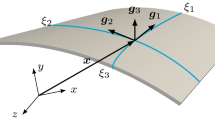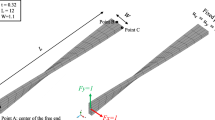The causes of computational locking in the shell theory are analyzed. The general cause of the phenomenon is shown to be rooted in variations calculus and related to the relationship between variable functions. As exemplified by a numerical case, the convergence may depend on the type of load.
Similar content being viewed by others
References
Yu. Yu. Abrosov, V. A. Maksymiuk, and V. S. Tarasiuk, “Straining long thin cylindrical shell with an elliptic cross section,” Visn. Zaporiz. Nats. Univ., Fiz.-Mat. Nauky, 2, 5–10 (2015).
À. I. Golovanov, O. N. Tyuleneva, and A. F. Shigabutdinov, Finite-Element Method in Statics and Dynamics of Thin-Wall Structures [in Russian], Fizmatizdat, Moscow (2006).
Yu. Yu. Abrosov, V. A. Maksimyuk, and I. S. Chernyshenko, “Influence of cross-sectional ellipticity on the deformation of a long cylindrical shell,” Int. Appl. Mech., 52, No. 5, 529–534 (2016).
K.-J. Bathe and D.-N. Kim, “A 4-node 3D-shell element to model shell surface tractions and incompressible behavior,” Comput. Struct., 86, 2027–2041 (2008).
T. Belytschko, W. K. Liu, and B. Moran, Nonlinear Finite Elements for Continua and Structures, John Wiley & Sons Ltd, Chichester, (2000).
D. Chapelle and K.-J. Bathe, “Fundamental considerations for the finite element analysis of shell structures,” Comput. Struct., 66, 19–36 (1998).
M. Geller, “A new method for derivation of locking-free plate bending finite elements via mixed/hybrid formulation,” Int. J. Numer. Meth. Eng., 26, 1185–1200 (1988).
Ya. M. Grigorenko, A. Ya. Grigorenko, and L. I. Zakhariichenko, “Analysis of influence of the geometrical parameters of elliptic cylindrical shells with variable thickness on their stress–strain state,” Int. J. Appl. Mech., 54, No. 2, 155–162 (2018).
F. Hanèn and S. Mani-Aouadi, “A conforming locking-free approximation for a Koiter shell,” Appl. Math. Comp., 339, 374–389 (2018).
G. M. Kulikov and E. Carrera, “Finite deformation higher-order shell models and rigid-body motions,” Int. Solids. Struct., 45, 3153–3172 (2008).
I. V. Lutskaya, V. A. Maksimyuk, and I. S. Chernyshenko, “Modelling the deformation of orthotropic toroidal shells with elliptical cross-section based on mixed functionals,” Int. Appl. Mech., 54, No. 6, 660–665 (2018).
V. A. Maksimyuk, “Study of the nonlinearly elastic state of an orthotropic cylindrical shell with a hole, using mixed functionals,” Int. Appl. Mech., 37, No. 12, 1602–1606 (2001).
V. A. Maksimyuk, E. A. Storozhuk, and I. S. Chernyshenko, “Variational finite-difference methods in linear and nonlinear problems of the deformation of metallic and composite shells (review),” Int. Appl. Mech., 48, No. 6, 613–687 (2012).
J. Pitkäranta, “Mathematical and historical reflections on the lowest-order finite element models for thin structures,” Comput. Struct., 81, 895–909 (2003).
G. Prathap, The Finite Element Method in Structural Engineering, Vol. 24, Ser.: Solid Mechanics and Its Applications, Kluwer Academic Publ., Dordrecht (1993).
E. Ramm and W. A. Wall, “Shell structures – a sensitive interrelation between physics and numerics,” Int. J. Numer. Meth. Eng., 60, 381–427 (2004).
B. Semper, “Locking in finite-element approximations to long thin extensible beams,” IMA J. Numer. Anal., 14, 97–109 (1994).
E. A. Storozhuk, I. S. Chernyshenko, and A. V. Yatsura, “Stress–strain state near a hole in a shear-compliant composite cylindrical shell with elliptical cross-section,” Int. Appl. Mech., 54, No. 5, 559–567 (2018).
E. A. Storozhuk and A. V. Yatsura, “Exact solutions of boundary-value problems for noncircular cylindrical shells,” Int. Appl. Mech., 52, No. 4, 386–397 (2016).
E. A. Storozhuk and A. V. Yatsura, “Analytical-numerical solution of static problems for noncircular cylindrical shells of variable thickness,” Int. Appl. Mech., 53, No. 3, 313–325 (2017).
Author information
Authors and Affiliations
Corresponding author
Additional information
Translated from Prikladnaya Mekhanika, Vol. 56, No. 3, pp. 99–103, May–June 2020.
Rights and permissions
About this article
Cite this article
Maksymyuk, V.A. Locking Phenomenon in Computational Methods of the Shell Theory. Int Appl Mech 56, 347–350 (2020). https://doi.org/10.1007/s10778-020-01017-7
Received:
Published:
Issue Date:
DOI: https://doi.org/10.1007/s10778-020-01017-7




